What does conservation success mean for vulnerable cranes, wild places, and communities?
How do we measure the impact of what we do? When should we celebrate success? We, and conservationists everywhere, struggle with when to take stock of our conservation impact and celebrate—and when it’s best to keep silent, boots on the ground. We need to evaluate, measure, and share what works, and what doesn’t work to scale up and deepen our conservation impact. The International Crane Foundation works worldwide to conserve cranes and the ecosystems, watersheds, and flyways on which they depend. But how do we know when cranes and other wildlife species, and the wild places they need, are “conserved?”

One important way to measure our conservation impact is through The Red List of Threatened Species, established in 1964 under the International Union for the Conservation of Nature (IUCN). It is the most widely recognized way to evaluate the risk of extinction for thousands of species worldwide. Species at low risk of extinction include Least Concern and Near-Threatened, with the latter considered at some risk of becoming endangered in the future. Threatened species on the Red List are categorized as high (Vulnerable), very high (Endangered), or extremely high (Critically Endangered) risk of extinction in the future. More than 37,400 species of plants and animals are on the Red List of threatened species, including 11 of the world’s 15 crane species until recently.
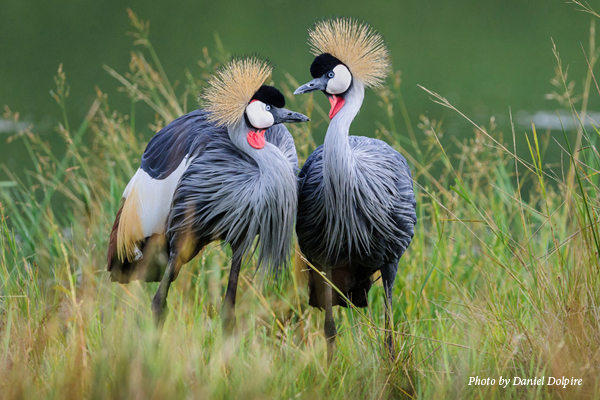
The Red List is invaluable for drawing attention to species in trouble. A decade ago, we presented significant data to change the Grey Crowned Crane’s status from “Least Concern” to “Endangered,” aimed at drawing attention to their alarming decline across Africa over the past 30 years and triggering government action to help us combat habitat loss and illegal trade. Just last month, the Red List was the basis for the first-ever legal protections passed for endangered birds in Mozambique, including Wattled and Grey Crowned Cranes.
Click here to watch Rich’s companion From the Field Series webinar on these complex issues.
Unfortunately, the Red List is much less useful for recovering species. When a species is moved to a less risky status, it should be cause for celebration, right? Not always. There is more to conservation success than reducing the imminent extinction of a species. For example, we need to understand whether a species is thriving across the places where they historically occurred, rather than just occupying a fragment of their former range. We need to understand whether emerging threats, like climate change and land development, are likely to undermine and reverse positive trends in population numbers in the future. And we need to understand how dependent a species is on the conservation actions we have taken and plan to take—what would happen if we claimed victory and stopped working?
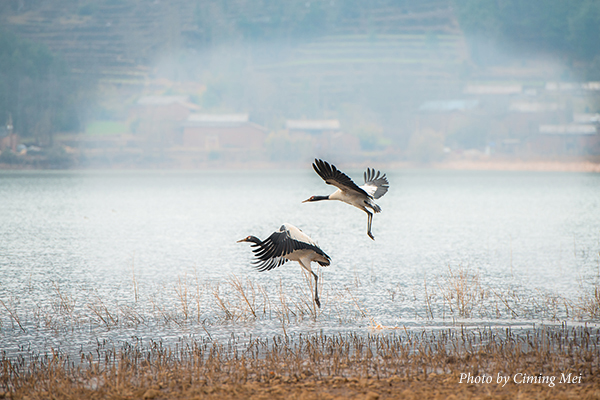
Recently, the Red List status of Black-necked Cranes and Red-crowned Cranes was adjusted to a less precarious category. Their story offers some celebration and plenty of concern for the future and how we think about conservation success. With a shift from Vulnerable to Near-Threatened, the Black-necked Cranes of central Asia are no longer included as a threatened species on the Red List. In recent decades, Black-necked Crane numbers have increased very steadily from about 5,000-6,000 in the 1990s to nearly 16,000 today. Many protected areas were created to secure thousands of acres of critical habitat for Black-necked Cranes in western China. Under the leadership of Dr. Li Fengshan, we built a large network of scientists and wildlife managers who are dedicated to the conservation of Black-necked Cranes. Our long-term project to secure Black-necked Cranes at Cao Hai was one of the first community-based conservation projects in China.
This is truly something to celebrate! But will it last? The wetlands of the Qinghai-Tibetan Plateau of China where Black-necked Cranes breed have flourished with increased meltwaters from Himalayan glaciers, but these glaciers are retreating rapidly due to climate change and soon these same wetlands could dry up. Without innovative ways to secure these wetlands, the future of these sacred birds remains in doubt.
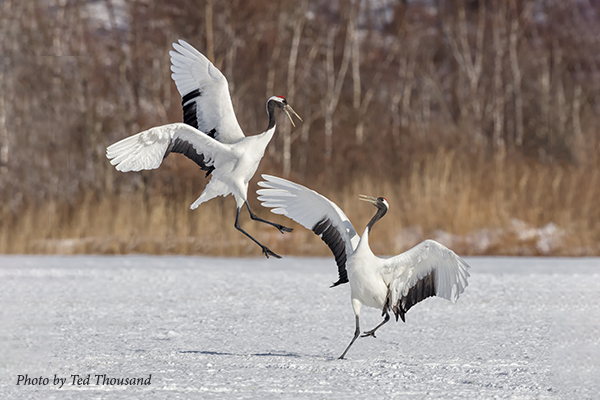
The status change of Red-crowned Cranes in East Asia from Endangered to Vulnerable is especially complicated. A resident population of Red-crowned Cranes is thriving on the island of Hokkaido in Japan but is largely sustained by feeding stations. The other two Red-crowned Crane populations that breed in northern China and Russia migrate to southern China or the Korean Demilitarized Zone for the winter, are highly threatened due to habitat loss and degradation, poisoning, and collection of eggs and chicks for wildlife trade. While we celebrate the increasing numbers of Red-crowned Cranes in Japan, it doesn’t show the bigger picture, and we know we have a long and challenging road ahead to prevent their extinction from the wild in rapidly developing China and Korea.
The new IUCN Green Status of Species, released this summer, offers a better way for us to think about the future of many crane species, and our success at securing them. The Green Status focuses on progress toward the full recovery of species in the wild to the extent possible, and the importance of conservation efforts in maintaining that progress. A species is fully recovered if it is present and functioning naturally in all parts of its range, including lands that may have been used prior to major human impacts or disruption. A new paper this month in Conservation Biology tests this new global standard for 181 wildlife species, including Critically Endangered Siberian Cranes of East Asia (led by the International Crane Foundation’s Claire Mirande and Research Associate Elena Ilyashenko) and Vulnerable Blue Cranes of southern Africa (led by Christie Craig of the International Crane Foundation/Endangered Wildlife Trust Africa Partnership). The study shows that both crane species, and many others, have great recovery potential but will depend on long-term conservation action if they are to continue their recovery in the wild.
As we apply the Green Status to other crane species over time, we can better illustrate the deep challenges that species like Black-necked and Red-crowned Cranes face on their path to recovery in the face of climate change, rapid development, or direct threats from people. We can also address our concern that governments or donors may reduce support or funding for species that move to a lower Red List category. For the Red-crowned Crane, the Green Status provides a valuable tool to justify the conservation investment needed for the long-term viability of each of their three population—and the likely consequences if funding and other resources are withdrawn. The budding IUCN Green List of Protected and Conserved Areas will help too by certifying conservation areas such as national parks, community conserved areas, and nature reserves that are effectively managed and fairly governed.
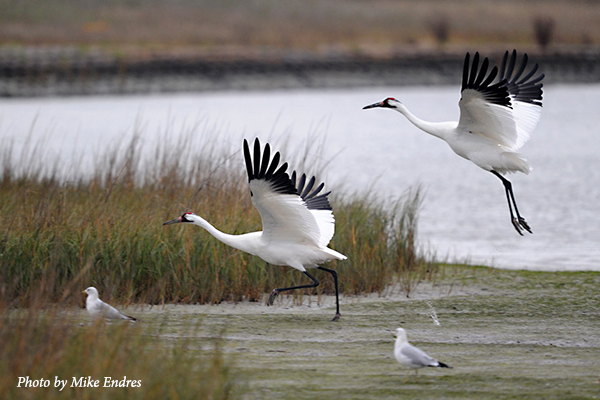
What will the Green Status tell us about our rarest and most abundant cranes here at home? We should absolutely celebrate the steady recovery of Endangered Whooping Cranes from the brink of extinction and hope for the day when they can be removed from the Red List. Protection from hunting through the Migratory Bird Treaty Act, land and water conservation in Texas, and a 20+ year commitment to Whooping Crane reintroduction to the eastern United States, is a big part of that recovery story. But we have a long way to go before Whooping Cranes successfully occupy their former range across North America, and we know that their recovery would cease without our ongoing efforts. The new Green Status will show a high recovery potential for Whooping Cranes in the future—but with a high dependence on long-term conservation action.
We should likewise celebrate the remarkable recovery of our Sandhill Cranes. We can see breathtaking numbers of Sandhill Cranes, more than 700,000 on migration, on the Platte River of Nebraska each spring. Sandhills are back in our everyday lives across Wisconsin, where their population has grown from a few breeding pairs last century to tens of thousands breeding across the state today. But the Green Status warns us that Sandhill Cranes are not thriving across all of their natural range. Climate change and prolonged drought in the western U.S. will deeply impact Sandhill Cranes in the coming years. Isolated populations in Mississippi and Cuba remain highly vulnerable to extinction. Increasing demand to hunt Sandhill Cranes on their breeding grounds in Wisconsin and Michigan, falsely linked to solving crop damage that has much better solutions, poses new challenges for their management and spread back to their historic range in the northeastern U.S. As we learned from the demise of the Passenger Pigeon, even abundant species need help to remain abundant in today’s world.
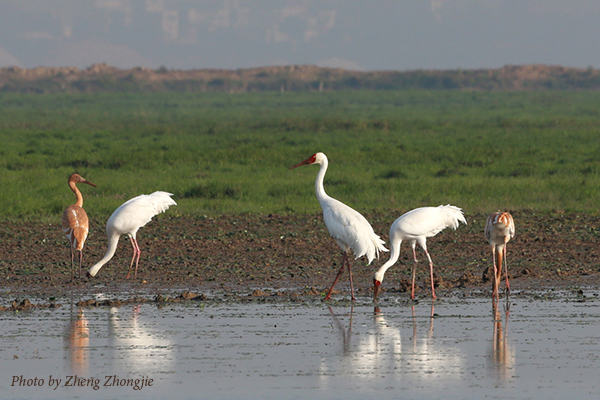
Green or red, no system paints the full conservation picture. The fate of many crane species is indelibly tied to the fate of the wild places they need. The entire world population of Siberian Cranes depends on the freshwater wetlands of Poyang Lake Nature Reserve to provide suitable wintering habitat for them, year in and year out. The success of Poyang Lake for cranes and the abundant wildlife it sustains, in turn, depends on resolving conflicting demands for water navigation, fisheries, and construction sand with the needs of wildlife. And that success must be repeated at every wetland stopover site that Siberian Cranes need on their 2,500-mile migration from northern breeding grounds to Poyang Lake each year.
Other crane species can thrive without wild places but need healthy farmlands that support wildlife. Sarus Cranes across India, Myanmar, and Vietnam need diverse agricultural lands interspersed with wetlands and disappear when these lands are supplanted with intensive monocultures of rice. Perhaps the best measure of Sarus Crane conservation success is the spread of our “Floating Rice 2.0″ initiative—a new way to sustain an old system by modernizing traditional floating rice as a more profitable and diverse alternative to industrial rice.
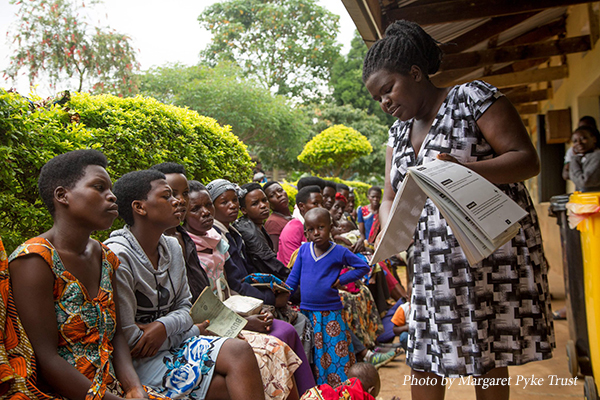
In many of the poorest places on earth, any measure of conservation success is inseparable from the status of the communities that share their lands with cranes. The impoverished rural communities of Uganda, Kenya, and Rwanda, the stronghold for Endangered Grey Crowned Cranes, will always put their need for food, water, health, and shelter first. There is no future for cranes or wetlands if these people have no viable future themselves. Through programs targeting population growth, public health, safe water, and sustainable livelihoods, including climate-smart agriculture, we need to increase the well-being and resilience of these communities. We need to expand our efforts at a formidable scale to make any lasting difference for conservation in this region and elsewhere.
So, let’s rejoice in having one fewer crane species on the Red List of threatened species. Let’s celebrate that our efforts are working for the recovery of many crane species as measured by the new Green Status. And let’s keep it going. We are in this for the long haul, and together we are making a difference.

Rich Beilfuss
President and CEO
